+++ UPDATEs 1+2+3 +++ When will Tiangong 2 crash?

The Chinese space station Tiangong 2 will perform a planned re-entry tomorrow, 19 July 2019. I don’t know at what time – I have not found that information anywhere. So I have to guess.
+++ Update 3: 2019/7/19 13:42 UTC +++
Chinese news outlets are reporting that Tiangong 2 is down and that re-entry happened starting at 13:06 UTC. So apparently they did make use of the first of the three opportunities I outlined in Update 1 below. I would have expected the second opportunity, but I guess they kept that as a backup, which then wasn’t needed as the first try had worked.
+++ Update 2: 2019/7/19 12:40 UTC +++
Normally when the owner of a big piece of space hardware knows that it will re-enter, a NOTAM (Notice to Airmen) and/or a NAVAREA warning to shipping is issued. I did not find a NOTAM for today and this region, but I did find a NAVAREA warning for region XIV (New Zealand/Oceania):

Using the stated bounding box I superimpose the groundtracks of the Tiangong 2 orbits and get the following:
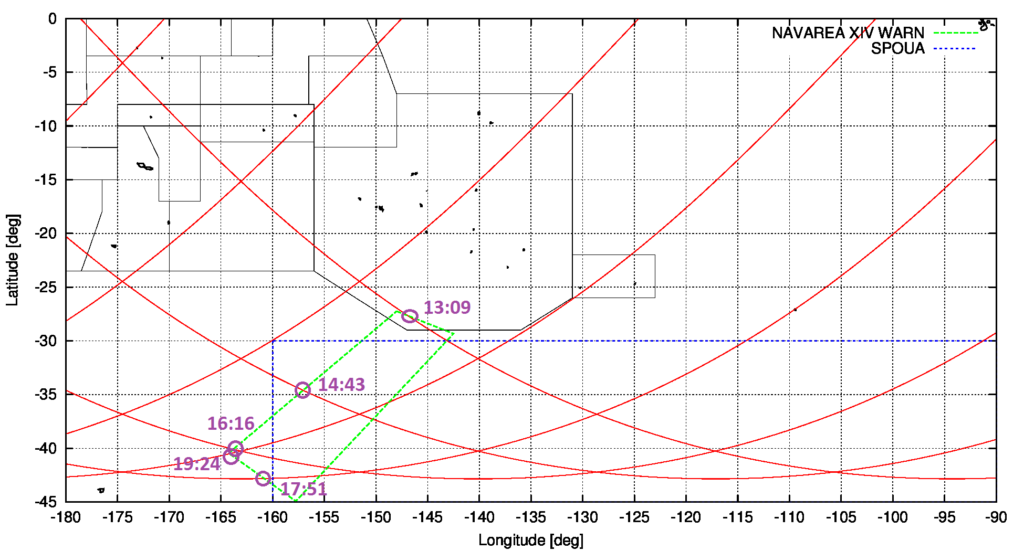
Interestingly, all three groundtracks for the possibilities I listed in Update 1 (below) intersect the bounding box. There are also some later ones that do, but the one at 17:51 UTC does not have a preceding pass over China and the one at 19:24 is after the perigee and therefore physically impossible to reach.
All later orbital revolutions do not cross the bounding box. However, the time state in the NAVAREA warning is 22:00:20 UTC to 23:00:50 UTC, which is 8 hours after the most likely reentry time I predict.
Incidentally, the China Standard Time is also UTC+8 hours, so perhaps …
+++ Update 1: 2019/7/19 08:00 UTC +++
Deorbit operations have started! This morning I checked the orbital elements on heavens-above.com and saw that the perigee has been lowered to 185 km in preparation of the de-orbit. What this means is that the final de-orbit manoeuvre that will be applied later today is approximately cut in half, to ca. 50 m/s.
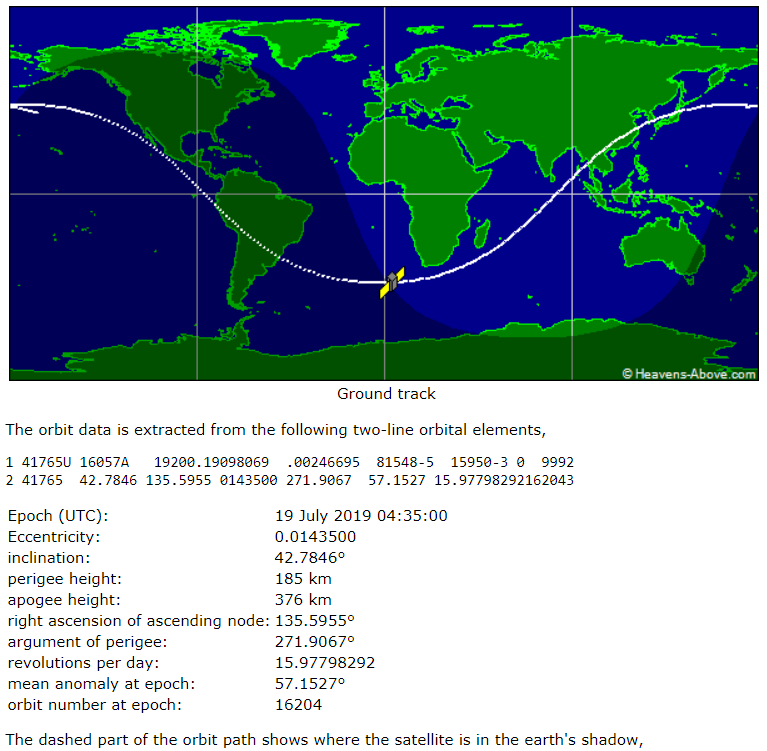
Based on this I re-did the calculation of those passes that cross China and then, half an orbit later, the SPOUA, and I obtained this:
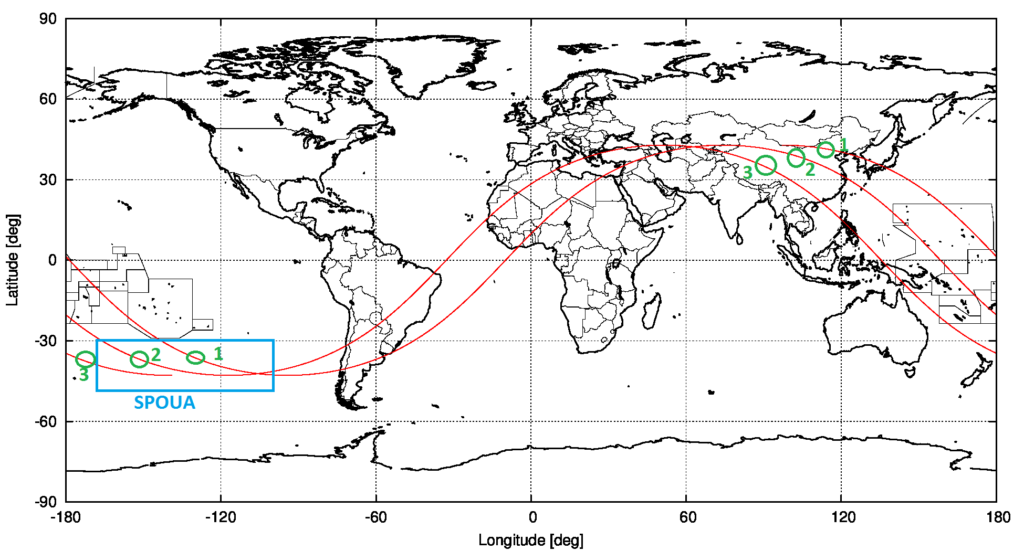
I have identified three possible options today where there would be visibility from China for the final de-orbit manoeuvre. These are marked 1, 2 and 3 in the above diagram.
Number 1 looks rather iffy in that the pass over China is not very long. Also, the entry location would be a bit further to the East, but still well within the SPOUA. If it’s this one, the final de-orbit burn should start around 12:36 UTC and re-entry will happen around 13:17 UTC.
Number 2 looks like the most credible scenario to me. If that’s the one, the final manoeuvre should start around 14:12 UTC and re-entry will happen around 14:49 UTC. This is earlier than I had predicted yesterday, but then I didn’t know that there would be that first perigee lowering manoeuvre – though it is perfectly logical to do the final operations in this way.
Number 3 offers good visibility from mainland China for the final de-orbit manoeuvre, but the re-entry location seems to lie rather far from the centre of the SPOUA. If it’s this one, the de-orbit manoeuvre will start around 15:45 UTC and re-entry will happen around 16:20 UTC.
My bet is that Tiangong 2 will meet its fiery demise today at around 14:50 UTC, which is less than 7 hours from now.
++++ End of Update 1 ++++
We all know that predictions can be rather tricky, especially when they pertain to future events. But here goes anyway.
We know that Tiangong 2’s final resting place will be in the SPOUA (South Pacific Ocean Uninhabited Area) within 160 and 90 degrees of Western longitude and 30 and 45 degrees of Southern latitude. That’s what the Chinese authorities say.
We also know the current orbital elements of Tiangong 2, which can be found, e.g., here. If the orbital state is known at one point, it can be computed for later times via numerical propagation, taking into account the relevant sources of orbital perturbations.
Right. I did that.
With the known orbital state at given times, the location on the Earth surface directly below Tiangong 2 can be computed. A sequence of locations at consecutive times leads to the ground track.
Tiangong 2 is in an almost circular orbit at an altitude of around 380 km. The orbital plane is inclined by 42.8 degrees with respect to the Earth equator. What the Chinese will do is to command Tiangong 2’s onboard computer to perform a braking manoeuvre.
For the manoeuvre the space station must be oriented such that its engines, little rocket motors, point forwards. Fowards means into the direction in which the space station is flying on its trajectory around the Earth at that time. This braking manoeuvre removes some of the orbital energy.
The orbital speed on Tiangong 2 is around 7.68 km/s. I don’t know the exact size of the braking manoeuvre, but I assume it will be around 100 – 110 m/s. Any less and the entry will be too shallow, so debris from the burn-up in the atmosphere would be spread over a wide region.
100 m/s doesn’t sound like much, compared to the orbital speed. But the manoeuvre can’t be much bigger or Tiangong 2 wouldn’t make it to the SPOUA from where the manoeuvre will happen. And anyway, there wouldn’t be enough propellant in the tanks for a much larger braking burn.
After the braking, Tiangong 2 will no longer be on a circular orbit, but rather on one that is slightly elliptical. The point closest to the Earth, the perigee, will be well within the Earth atmosphere. When the space station appraches perigee, it’s curtains-
After the braking manoeuvre will have ended, Tiangong 2 will cruise along on its orbit for 40 minutes or so, gradually descending towards perigee. As the space station descends below 110 km, atmospheric drag will get so strong that fragile components start breaking off. By that time, it will be far from China and already above the South Pacific Ocean.
As the spacecraft descends further, it enters the denser atmosphere. Drag deceleration will then increase sharply and friction will cause intense heating – to the point that its metal structure will melt and and burn. However, Tiangong 2 will not burn up completely – at almost 9 tons it is far too massive. Quite a lot of debris, large and small, will get through.
That’s why they are targeting the SPOUA.
All of the above is a certainty. But I still don’t know at what time tomorrow all of this will happen. So here comes my guess.
First of all, I look at tomorrow’s ground track – specifically, only those parts of the ground track that pass first over China and then over the SPOUA. China is situated on the globe such that sometimes Tiangong 2 passes squarely over China and then, half an orbit on, squarely over the SPOUA. I am looking for those times when that happens.
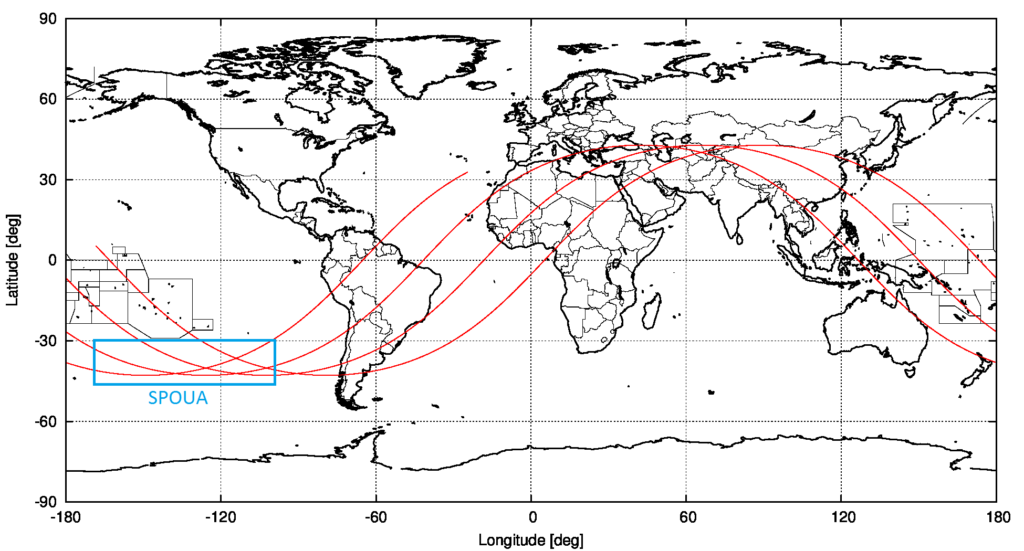
As you can see, the passes above China are not all the same. The one in the middle is better than the preceding and the following ones. It spends much more time over Chinese territory and passes right through, rather than just skirting the edges. My bet is that the Chinese will opt for that pass to perform the de-orbit burn. So lets look at that one.
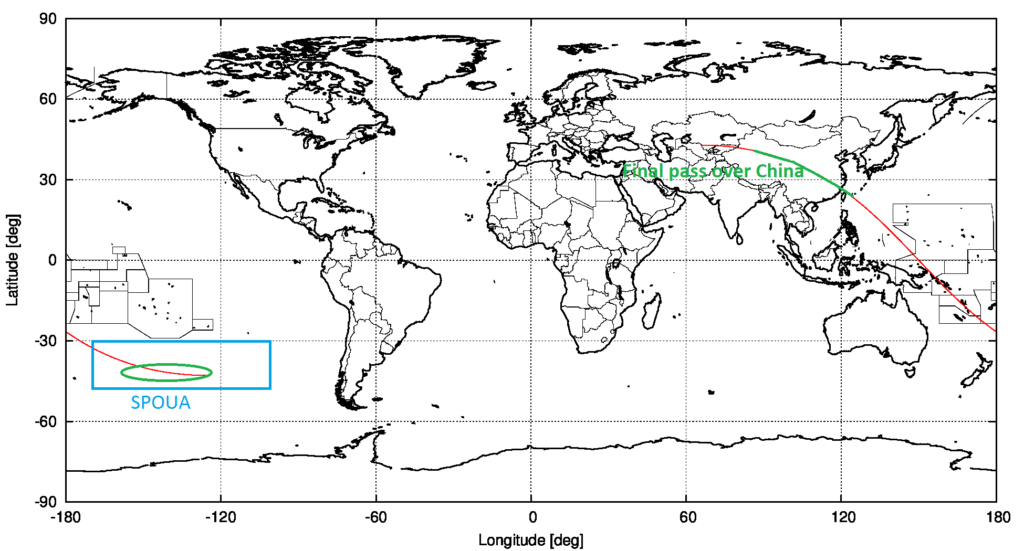
On this one pass I picked out, Tiangong will cross the Chinese border and thus can be tracked from a number of ground stations in China at around 14:40 UTC. My guess is that around at that time the deorbiting manoeuvre will commence.
It will take some time to complete because Tiangong 2 is a large and heavy spacecraft and its engines are relatively small. Throughout the duration of the manoeuvre, a sequence of ground stations will be seeing Tiangong 2. These ground stations will receive telemetry transmitted by the spacecraft, so the control centre can monitor how the deorbit manoeuvre is progressing.
The East coast of China will be crossed around 14:51 UTC. China is a big place, so even a spacecraft moving at almost 8 km per second needs 11 minutes to traverse the country.
At that point, Tiangong 2 will be irrevocably facing doom. Burn-up should start less than half an hour later, around 15:20 UTC.
Disclaimer
Please keep in mind that all of this is just my guess. What’s yours?
My colleague basically agrees with my assessment but thinks they might plan the deorbit for the pass preceding the optimal one that starts at 14:40 UTC. By doing that, the optimal pass could serve as backup, in case something goes wrong and the baseline opportunity is missed. If my colleague is right, Tiangong 2 will crash one and a half hours earlier than I thought, around 13:50 UTC.
We’ll see. Bets, anyone?


Hallo Herr Khan,
ich hoffe, dass niemand auf Ihr Wettangebot eingegangen ist. Aber Danke erneut für Ihre aktuellen und kompetenten Informationen!
rok
Zum Glück hat keiner mit mir gewettet, denn ich hatte ja eigentlich die zweite der drei Gelegenheiten favorisiert und hätte damit die Wette verloren.
Vielen Dank für Ihre Information! Ich habe alle Updates mitverfolgt. Ich weiß, dass der Wiedereintritt auch von Objekten dieser Größe als etwas Alltägliches angenommen werden soll. Ihn so zeitnah mitzuverfolgen ist dennoch spannend 🙂